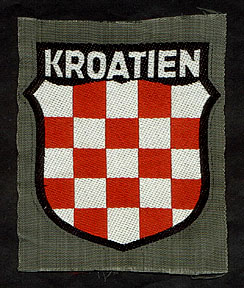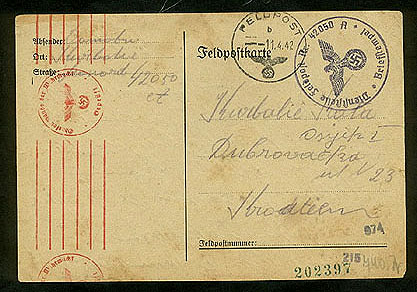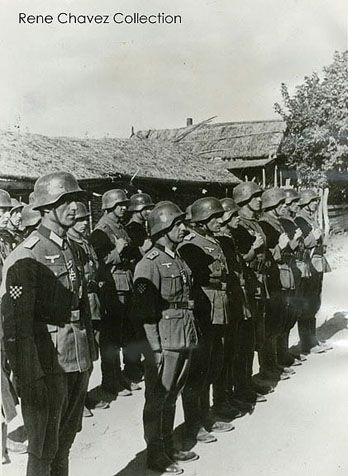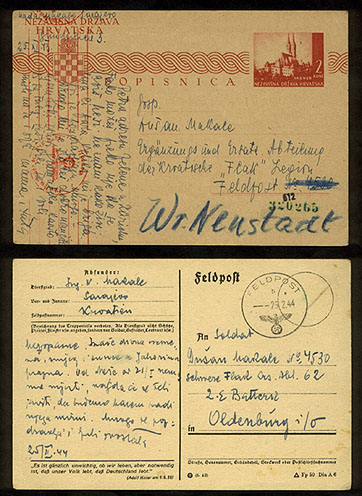
369th Croatian Reinforced Infantry Regiment
The independent state of Croatia was formed on 10 April 1941,
ten days after the Axis invasion of Yugoslavia. Croatia being
the chief beneficiary annexed Bosnia and Herzegovina, which
is a Muslim state. Its founder was Ante Pavelic, political leader
of the Ustasha party, which had nationalistic, catholic and
anti-Serb policies. During the Russian campaign, Croatians volunteered
to fight alongside Germany. 
369th Infantry Feldpost Rare feldpost card mailed on April 11, 1942 by a Croatian volunteer of the 369th Infantry Regiment. Sender shows FPN 42050A indicating that he was assigned to the 2nd Battalion/5th Company. The feldpost card shows the unit seal and has been censored. By April 1942, the 369th Regiment was attached to the German 6th Army and already advancing towards the Don River. The 369th Infantry Regiment in Stalingrad
After a year in existence, in July 1942, the regiment advance
on the Don River at the collective farm Kolhoz near Selivanovo,
members of the regiment fought often at close quarters defeating
repeated Russian counter-attacks. The Croatians casualties were
high 46 dead and 176 wounded. 
By January 1943, German 6th Army surrendered to the Russians,
who captured the last remnants of the 369th Croatian Regiment.
Only less then 100 men lead by Lt-Col Mesic surrendered on 2
February 1943, at the building of the Soviet Airforce Academy. | |
|
Croatian Postal History Postal History:Initially Croatian and Italian volunteers serving in German units paid for postage. By 24 July 1942, the Croatian government made an agreement with Germany that postcards and letters weighing from 100gms up to 250gms could be sent through the Feldpost service between members of the German and Croatia forces. Airmail service was free of charge, special Luftfeldost labels were provided to each soldier. A postal charge of 20Rpf in Germany and 7.50Kuna in Croatia was applied to packages weighing from 250gms to 1000gms.
Feldpost numbers were assigned to all Croatian formations. | |
|
| |
| Regimental Staff | 40508 |
| I Battalion (1-4 Co.) | 41457 A-E |
| II Battalion (5-8 Co.) | 42050 A-E |
| III Battalion (9-12 Co.) | 43170 A-E |
| 13 Company | 44152 |
| 14 Company | 44926 |
| Column | 45484 |

Above are two feldpost covers mailed by Croatian volunteers.
The top cover is dated November 1943 to Wr. Neustadt, Austria
where the Croatian Flak Legion was in training. |
|
369th Infantry Division Feldpost
When the 369th Infantry Regiment was destroyed during the battle
of Stalingrad a new 369th Infantry Division was formed in December
1942. |
| 369th. Div. Hdqtrs. | 17796 | ||
| Grenadier Rgt. 369 Staff Rgt. | 21425 A-E | Staff Grenadier Rgt. 370 | |
| 1st. Battalion (1-4 Co.) | 15183 A-D | 1st. Battalion (1-4 Co.) | 25808 A-D |
| II Battalion (5-8 Co.) | 19762 A-D | II Battalion (5-8 Co.) | 26323 A-D |
| III Battalion (9-12 Co.) | 13549 A-D | III Battalion (9-12 Co.) | 27388 A-D |
| Staff Rgt. (13-14 Co.) | 12923 A-B | 13th. Company | 22351 |
| 369th Reconn.Unit Staff | 23521 | 14th. Company | 23274 |
| 1st. Motorcycle Squad | 24358 | Engineer Battalion 369 | |
| 2nd. Motorcycle Squad | 03836 | Staff | 26373 |
| 3rd. Motorcycle Squad | 25711 | 1st. Company | 27165 |
| 369th,Artillery Rgt. | 2nd. Company | 28975 | |
| Staff Rgt. & Field Battr | 30428 | 3rd. Company | 05369 |
| I Battalion (1-3 Co.) | Column | 29559 | |
| with Coast Battr. 3A | 14305 | Anti-tank Unit | |
| II Btl. & Coast | Staff | 18676 | |
| Battr. 6A (4-6 Co.) | 31151 A-C | 1st.Company | 19587 |
| III Battalion (7-8 Co.) | 2nd. Company | 22374 | |
| with Coast Battr. 8A | 32040 A-B | Training Brigade Mixed Reserve | |
| SIgnal Unit 369 Staff | 41059 | Btl. (1-2) Eng. Co. | 57630* |
| 1st. Company | 42522 | Training Bgd. Conv. Unit | 58207 |
| 2nd. Company | 43710 | XVII Battalion Staff | 34311 |
| 1st. Motor Ambulance Plat. | 45006 | Bakery Company | 47101 |
| 2nd. Motor Ambulance Plat. | 44105 | Military Police | 47380 |
| Medical Company | 46276 | Motor Vehicle Repair Co. | 39602 |
| Veterinary Company | 42963 | Field Reserve Battalion | 57588 |
| Butcher Company | 46007 | Administrated Company | 45960 |
| Croatian Special French-Arab Co. | 33309 | ||
| Croatian Mountain Brigade | Supply Transport 369 | ||
| (German Trained) Battalion 1 | 11693 | Small Motor Transport | 34283 |
| Croatian Mountain Brigade | 2nd. Transp. Col. | 35308 | |
| (German Trained) Battalion 2 | 04767 | 2nd. Transp. Squad | 38541 |
| Croatian Mountain Brigade | 3rd. Transp. Squad | 36016 | |
| (German Trained) Battalion 3 | 08868 | 4th. Transp. Col. | 37465 |
| Supply | 40365 | ||
| Reserve Training Units | |||
| Light Artillery Unit | 46511 | ||
| Training Brigade | 59875 | ||
| I Battalion | 56478 | ||
| II Battalion | 59099 | ||
| III Battalion | 57364 | ||
| IV Battalion | 56925 | ||
| Reserve Regiment | 41700 | ||
| Training Artillery Brigade | 56756 | ||
| Training Artillery Res. Rgt. | 26455 |

The cover above was mailed in 1944 from FPN 57364E, indicating
the the volunteer was in the 369th Inf. Div./Training Brigade/3rd
Btl. Croatian 373rd & 392nd Infantry Division Feldpost
In September 1943, the 373rd & 392nd Infantry Divisions were
formed. The
373rd Infantry Division was referred as the Tiger
Division and was under the command of Lt-General Emil Zellner,
a German. This division fought against Tito's partisans however,
it suffered continuous desertion of its personnel. |
[ Front Page ] [ Top] [Previous Page [Next Page]